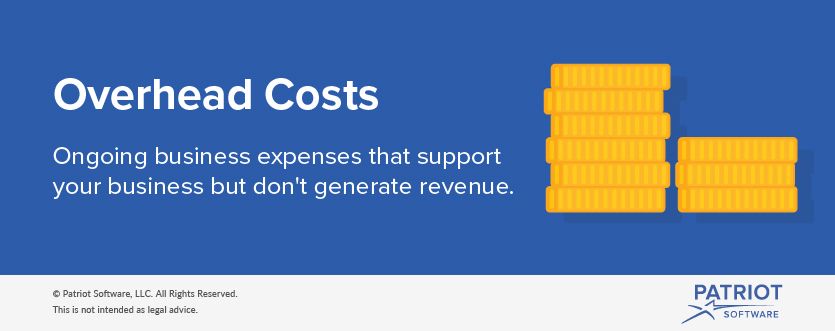Overhead costs are necessary business expenses. You need them to run your business. You can never get rid of them, but you can reduce them. Discover types of overhead costs and how to calculate how much overhead you have.
What is overhead cost?
Overhead costs are ongoing business expenses that support your business but do not generate revenue. Overhead expenses are indirect costs, meaning they are not related to specific business activities that generate money. You must pay overhead costs no matter what, even when business is slow. You will have some overhead costs to keep your business running.

Examples of overhead costs
Overhead costs for small businesses are similar to the overhead costs large businesses experience. The costs can vary depending on your industry and whether you’re an online or brick-and-mortar business.
There are three types of overhead costs: fixed, variable, and semi-variable.
Fixed overhead costs
Fixed overhead costs are the same amount every month. These overhead costs do not fluctuate with business activity. Fixed costs include rent and mortgage payments, some utilities, insurance, property taxes, depreciation of assets, annual salaries, and government fees.
Variable overhead costs
Variable overhead costs are affected by business activity. When you have increased business activity, these overhead costs will likely increase, too. And, when you have decreased business activity, variable overhead expenses decrease and are sometimes eliminated. Variable overhead costs include shipping, legal expenses, materials, office supplies, equipment maintenance, advertising, and consulting services.
Semi-variable overhead costs
Semi-variable overhead costs are present no matter what, but the cost will slightly fluctuate. These overhead costs might have a base rate that you must always pay and a variable rate determined by usage. Semi-variable overhead expenses include some utilities, vehicle usage, hourly wages with overtime, and salespeople’s salaries and commissions.
An overhead cost for one company might be a direct production cost for another. For example, a marketing agency will likely list rent as an overhead cost, while a production facility will likely list rent as a direct cost.
Some types of expenses might be both direct and indirect costs for your business, depending on the situation. For example, wages paid to a seamstress at a dress shop might be a direct cost because her work increases your business’s revenue. However, wages paid to an in-house accountant are an overhead cost.
Why you must know your overhead costs
Knowing your business’s overhead costs has many benefits.
Understanding your overhead costs can help you set prices that result in profits. You can factor overhead into the total cost to run your business, telling you how much money your business needs to bring in.
You can use your overhead costs to determine your net profit, also called the bottom line. You will take your gross profit and subtract all expenses, including overhead, to calculate your net profit. Your net profit will tell you if your business is actually making money or if your expenses are more than your revenue.
You can also look at your business overhead expenses to find ways to reduce them. If you have a large expense or one that’s been creeping up over time, you might want to examine it. Reducing your overhead expenses will increase your net profit.
How to calculate overhead costs
Before you can properly record your overhead expenses, you need to calculate overhead costs. After you calculate your total overhead costs, you might also calculate overhead rates for specific time periods. The overhead rate will compare your overhead expenses to your revenue.
The first step of calculating overhead is determining each of your overhead costs for a specific time period. Remember, an overhead expense for one business might be a direct cost for another.
Once you determine all of your overhead expenses, add them together. The overhead calculation for a specific time period is as simple as that.
Now that you know your total overhead costs, you can calculate your overhead rate. To get your overhead rate, you will divide your overhead costs for a specific time period by your sales for the same time period.
Overhead Rate = Overhead Costs / Sales
Let’s say your business had $5,000 in overhead costs last month and $45,000 in sales.
$5,000 / $45,000 = .11 or 11%
In terms of dollars, your business spends 11 cents on overhead for every dollar it makes.
The smaller your overhead rate, the bigger your net income.
Keep track of your small business’s expenses with easy-to-use accounting software. Get a free trial of Patriot’s online accounting software and see how simple it is.
This article is updated from its original publication date of 10/14/2015.
